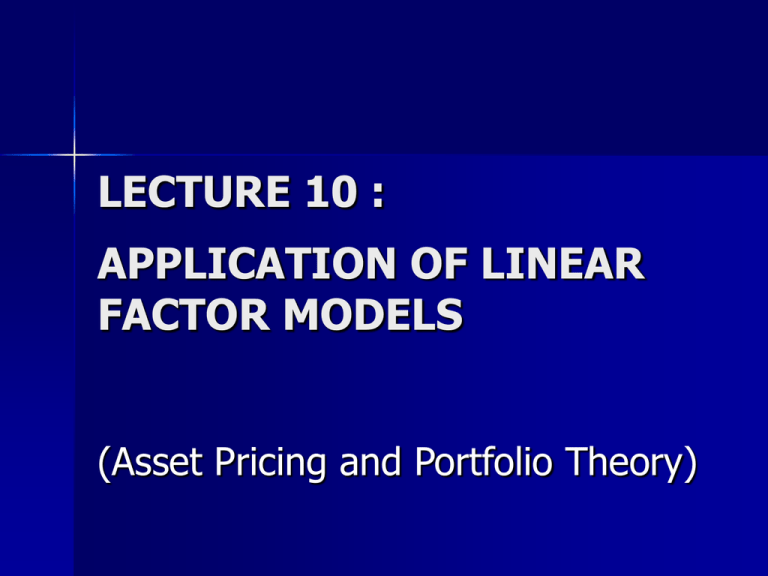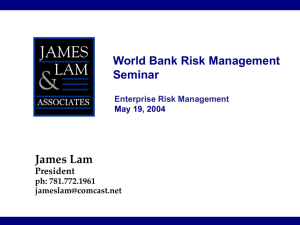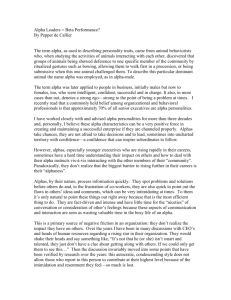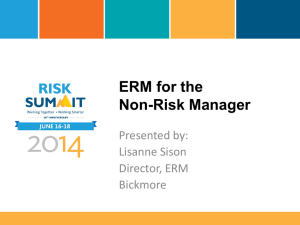Lecture 10
advertisement

LECTURE 10 :
APPLICATION OF LINEAR
FACTOR MODELS
(Asset Pricing and Portfolio Theory)
Contents
Mutual fund industry
Measuring performance of mutual funds
(risk adjusted rate of return)
Jensen’s alpha
Using factor models to measure fund
performance due luck or skill
Active vs passive fund management
Newspaper Comments
The Sunday Times 10.03.2002
‘Nine out of ten funds underperform’
The Sunday Times 10.10.2004
‘Funds take half your growth in fees’
Introduction
Diversification in practice : invest in different mutual
funds, with different asset classes (e.g. bonds,
equity), different investment objectives (e.g. income,
growth funds) and different geographic regions.
Should we buy actively managed funds or index
trackers ?
Assets under management
– US mutual fund industry : over $ 5.5 trillion (2000), with $ 3
trillion in equity funds
Number of funds
– US : 393 funds in 1975, 2424 in 1995 (main US database)
– UK : 1167 funds in 1996, 2222 in 2001 (yearbook)
UK Unit Trust Industry
UK Unit Trusts : Number of Funds
UK Unit Trusts : Assets under Management
2500
350000
300000
2000
250000
1500
200000
150000
1000
100000
500
50000
0
1996
1997
1998
1999
2000
Number of Funds
2001
0
1996
1997
1998
1999
2000
2001
Assets under Management
Classification of Unit
Trusts - UK
Income Funds (7 subgroups)
Growth Funds (21 subgroups)
UK Corporate Bonds (74 funds)
Global Bonds (52 funds)
UK Equity and Bond Income (46 funds)
UK Equity Income (85 funds)
Global Equity Income (4 funds)
…
UK All Companies (290 funds)
UK Smaller Companies (73 funds)
Japan (75 funds)
North America (84 funds)
Global Emerging Markets (23 funds)
Properties (2 funds)
…
Specialist Funds (3 subgroups)
Fund Performance : Luck
or Skill
Financial Times, Mon 29th
of Nov. 2004
Who Wants to be a
Millionaire ?
Suppose £ 500,000 question :
Which of these funds’ performance is not due
to luck ?
(A.) Artemis ABN AMRO Equity Income
Alpha = 0.4782
t of alpha = 2.7771
Alpha = 0.2840
t of alpha = 2.6733
Alpha = 0.3822
t of alpha = 2.4035
Alpha = 0.4474
t of alpha = 2.0235
(B.) AXA UK Equity Income
(C.) Jupiter Income
(D.) GAM UK Diversified
Measuring Fund Performance :
Equilibrium Models
1.) Unconditional Models
CAPM : (ERi – rf)t = ai + bi(ERm – rf)t + eit
Fama-French 3 factor model :
(ERi – rf)t = ai + b1i(ERm–rf)t + b2iSMLt + b3i HMLt + eit
Carhart (1997) 4 factor model
(ERi–rf)t = ai +b1i(ERm–rf)t + b2iSMLt + b3iHMLt + b4iPR1YRt+ eit
2.) Conditional (beta) Models
Z = {z1, z2, z3, …}, Zt’s are measured as deviations from their
mean
bi,t = b0i + B’(zt-1)
CAPM : (ERi – rf)t = ai + bi(ERm – rf)t + B’i(zt-1 [ERm - rf]t) + eit
Measuring Fund Performance :
Equilibrium Models (Cont.)
3.) Conditional (alpha-beta) Models
Z = {z1, z2, z3, …}
bi,t = b0i + B’(zt-1) and
ai,t = a0i + A’(zt-1)
CAPM : (ERi – rf)t = a0i + A’i(zt-1) + bi(ERm – rf)t
+ B’i(zt-1 [ERm - rf]t) + eit
4.) Market timing Models
(ERi – rf)t = ai + bi(ERm – rf)t + gi(ERm - rf)2t + eit
(ERi – rf)t = ai + bi(ERm – rf)t + gi(ERm - rf)+t + eit
Case Study :
Cuthbertson, Nitzsche and
O’Sullivan (2004)
UK Mutual Funds / Unit
Trusts
Data :
– Sample period :
monthly data
April 1975 – December 2002
– Number of funds : 1596 (‘Live’ and ‘dead’
funds)
– Subgroups : equity growth, equity
income, general equity, smaller
companies
Model Selection :
Assessing Goodness of Fit
Say, if we have 800 funds, have to
estimate each model for each fund
Calculate summary statistics of all the
funds regressions : Means
R2
Akaike-Schwartz criteria (SIC) : is adding an
extra variable worth losing a degree of freedom
Also want to look at t-statistics of the extra
variables
Methodology :
Bootstrapping Analysis
When we consider uncertainty across all funds (i.e. L
funds) – do funds in the ‘tails’ have skill or luck ?
For each fund we estimate the coefficients (ai, bi) and
collect the residuals based on all the data available for
the fund (only funds with at least 60 observations are
included in the analysis).
Simulate the data, under the null hypothesis that each
fund has ai = 0.
Alphas : Unconditional FF
Model
Residuals of Selected
Funds
Methodology :
Bootstrapping
Step 1 : Generating the simulated data
(ERi – rf)t = 0 + b1i(ERm – rf)t + Residit
Simulate L time series of the excess return under the null
of no outperformance.
Bootstrapping on the residuals (ONLY)
Step 2 : Estimate the model using the
generated data for L funds
(ERi – rf)t = a1 + b1(ERm – rf)t + eit
Methodology :
Bootstrapping (Cont.)
Step 3 : Sort the alphas from the L - OLS
regressions from step 2
{a1(1), a2(1), …, aL(1)} amax(1)
Repeat steps 1, 2 and 3 1,000 times
Now we have 1,000 highest alphas all under
the null of no outperformance.
Calculate the p-values of amax (real data) using
the distribution of amax from the bootstrap
(see below)
The Bootstrap Alpha
Matrix (or t-of Alpha)
Funds
Bootstraps
1
2
3
4
…
1
a1,1
a2,1
a3,1
a4,1
… a849,1
a850,1
2
a1,2
a2,2
a3,2
a4,2
… a849,2
a850,2
3
a1,3
a2,3
a3,3
a4,3
… a849,3
a850,3
4
a1,4
a2,4
a3,4
a4,4
… a849,4
a850,4
…
…
…
…
…
a3,999
a4,999
999
a1,999
a2,999
1000
a1,1000
a2,1000 a3,1000 a4,1000
…
849
…
… a849,999
850
…
a850,999
… a849,1000 a850,1000
The Bootstrap Matrix –
Sorted from high to low
Bootstraps
Highest
2nd
3rd
highest highest
4th
highest
…
2nd
Worst
Worst
1
a151,1
a200,1
a23,1
a45,1
…
a800,1
a50,1
2
a23,2
a65,2
a99,2
a743,2
…
a50,2
a505,2
3
a55,3
a151,3
a78,3
a95,3
…
a11,3
a799,3
4
a68,4
a242,4
a476,4
a465,4
…
a352,4
a444,4
…
…
…
…
…
…
…
…
999
a76,999
a12,999
a371,999 a444,999
…
a31,999
a11,999
1000
a17,1000
a9,1000
a233,100 a47,1000
…
a12,1000
a696,1000
0
Interpretation of the p-Values
(Positive Distribution)
Suppose highest alpha is 1.5 using real data
If p-value is 0.20, that means 20% of the a(i)max
(i = 1, 2, …, 1000) (under the null of no
outperformance) are larger than 1.5
LUCK
If p-value is 0.02, that means only 2% of the
a(i)max (under the null) are larger than 1.5
SKILL
Interpretation of the p-Values
(Negative Distribution)
Suppose worst alpha is -3.5
If p-value is 0.30, that means 30% of the a(i)min
(i = 1, 2, …, 1000) (under the null of no
outperformance) are less than -3.5
UNLUCKY
If p-value is 0.01, that means only 1% of the
a(i)min (under the null) are less than -3.5
BAD SKILL
Other Issues
Instead of using sorting according to
the alphas, we can sort the funds by
the t of alphas (or anything else !)
Different Models – see earlier discussion
Different Bootstrapping – see next slide
Other Issues (Cont.)
A few questions to address :
– Minimum length of fund performance
date required for fund being considered
– Bootstrapping on the ‘x’ variable(s) and
the residuals or only on the residuals
– Block bootstrap
Residuals of equilibrium models are often
serially correlated
UK Results :
Unconditional Model
Fund Position
Actual alpha
Actual t-alpha
Bootstr. P-value
Top Funds
Best
0.7853
4.0234
0.056
2nd best
0.7239
3.3891
0.059
10th best
0.5304
2.5448
0.022
15th best
0.4782
2.4035
0.004
Bottom Funds
15th worst
-0.5220
-3.6873
0.000
10th worst
-0.5899
-4.1187
0.000
2nd worst
-0.7407
-5.1664
0.001
Worst
-0.9015
-7.4176
0.000
Bootstrap Results : Best
Funds
Bootstrapped Results :
Worst Funds
UK Mutual Fund Industry
Summary
Asset returns are not normally
distributed
Hence should not use t-stats
Skill or luck : Evidence for UK
– Some top funds have ‘good skill’, good
performance is luck for most funds
– All bottom funds have ‘bad skill’
References
Cuthbertson, K. and Nitzsche, D. (2004)
‘Quantitative Financial Economics’, Chapters 9
Cuthbertson, K., Nitzsche, D. and O’Sullivan, N.
(2004) ‘Mutual Fund Performance : Skill or
Luck’, available on
http://www.cass.city.ac.uk/faculty/d.nitzsche/research.html
END OF LECTURE








